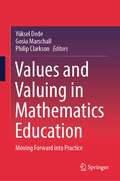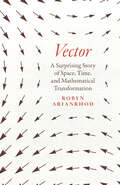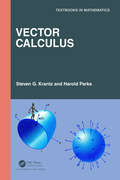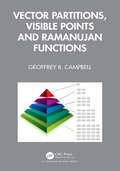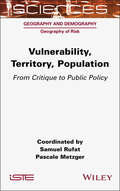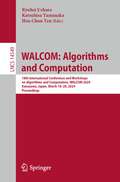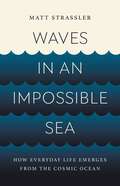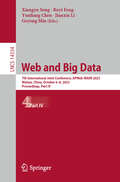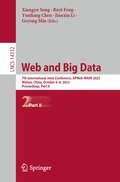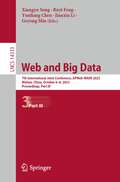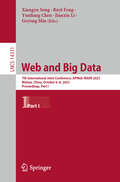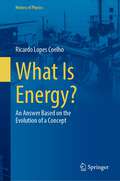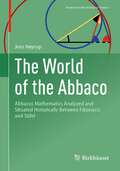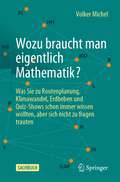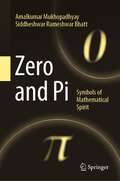- Table View
- List View
Value of Information for Healthcare Decision-Making (Chapman & Hall/CRC Biostatistics Series)
by Anna Heath Natalia Kunst Christopher JacksonValue of Information for Healthcare Decision-Making introduces the concept of Value of Information (VOI) use in health policy decision-making to determine the sensitivity of decisions to assumptions, and to prioritise and design future research. These methods, and their use in cost-effectiveness analysis, are increasingly acknowledged by health technology assessment authorities as vital. Key Features: Provides a comprehensive overview of VOI Simplifies VOI Showcases state-of-the-art techniques for computing VOI Includes R statistical software package Provides results when using VOI methods Uses realistic decision model to illustrate key concepts The primary audience for this book is health economic modellers and researchers, in industry, government, or academia, who wish to perform VOI analysis in health economic evaluations. It is relevant for postgraduate researchers and students in health economics or medical statistics who are required to learn the principles of VOI or undertake VOI analyses in their projects. The overall goal is to improve the understanding of these methods and make them easier to use.
Value of Information for Healthcare Decision-Making (Chapman & Hall/CRC Biostatistics Series)
Value of Information for Healthcare Decision-Making introduces the concept of Value of Information (VOI) use in health policy decision-making to determine the sensitivity of decisions to assumptions, and to prioritise and design future research. These methods, and their use in cost-effectiveness analysis, are increasingly acknowledged by health technology assessment authorities as vital. Key Features: Provides a comprehensive overview of VOI Simplifies VOI Showcases state-of-the-art techniques for computing VOI Includes R statistical software package Provides results when using VOI methods Uses realistic decision model to illustrate key concepts The primary audience for this book is health economic modellers and researchers, in industry, government, or academia, who wish to perform VOI analysis in health economic evaluations. It is relevant for postgraduate researchers and students in health economics or medical statistics who are required to learn the principles of VOI or undertake VOI analyses in their projects. The overall goal is to improve the understanding of these methods and make them easier to use.
Values and Valuing in Mathematics Education: Moving Forward into Practice
by Yüksel Dede Gosia Marschall Philip ClarksonThis book is a follow-up to 'Values and Valuing in Mathematics Education: Scanning and Scoping the Territory' (2019, Springer). This book adds a critical emphasis on practice and fosters thinking concerning positive mathematical well-being, engagement, teacher noticing, and values alignment among a range of critical notions that intersect with values and valuing. Values and valuing play a key role in many aspects of education, such as assessment, planning, classroom interactions, choosing tasks, and general well-being. What one values and finds important in the learning and teaching of mathematics operates within the intersection of all social, cognitive, and affective aspects of school pedagogy, making values a significant holistic factor in education. The chapters explore potential teaching strategies that enhance the understanding of the central place of values in mathematics itself as a subject, as well as how values impact how mathematics is used withinsociety. This book includes examples of strategies for facilitating students’ meaningful engagement with, and conscious learning of, values when engaging in mathematical thinking and doing.
Vector: A Surprising Story of Space, Time, and Mathematical Transformation
by Robyn ArianrhodA celebration of the seemingly simple idea that allowed us to imagine the world in new dimensions—sparking both controversy and discovery. The stars of this book, vectors and tensors, are unlikely celebrities. If you ever took a physics course, the word “vector” might remind you of the mathematics needed to determine forces on an amusement park ride, a turbine, or a projectile. You might also remember that a vector is a quantity that has magnitude and (this is the key) direction. In fact, vectors are examples of tensors, which can represent even more data. It sounds simple enough—and yet, as award-winning science writer Robyn Arianrhod shows in this riveting story, the idea of a single symbol expressing more than one thing at once was millennia in the making. And without that idea, we wouldn’t have such a deep understanding of our world. Vector and tensor calculus offers an elegant language for expressing the way things behave in space and time, and Arianrhod shows how this enabled physicists and mathematicians to think in a brand-new way. These include James Clerk Maxwell when he ushered in the wireless electromagnetic age; Einstein when he predicted the curving of space-time and the existence of gravitational waves; Paul Dirac, when he created quantum field theory; and Emmy Noether, when she connected mathematical symmetry and the conservation of energy. For it turned out that it’s not just physical quantities and dimensions that vectors and tensors can represent, but other dimensions and other kinds of information, too. This is why physicists and mathematicians can speak of four-dimensional space-time and other higher-dimensional “spaces,” and why you’re likely relying on vectors or tensors whenever you use digital applications such as search engines, GPS, or your mobile phone. In exploring the evolution of vectors and tensors—and introducing the fascinating people who gave them to us—Arianrhod takes readers on an extraordinary, five-thousand-year journey through the human imagination. She shows the genius required to reimagine the world—and how a clever mathematical construct can dramatically change discovery’s direction.
Vector Calculus (Textbooks in Mathematics)
by Harold Parks Steven G. KrantzUsing meaningful examples, credible applications, and incisive technology, Vector Ca1culus strives to empower students, enhance their critical thinking skills, and equip them with the knowledge and skills to succeed in the major or discipline they ultimately choose to study. This text is intended to be a cornerstone of that process. An engaging style and clear writing make the language of mathematics accessible, understandable, and enjoyable, with a high standard for mathematical rigor.A calculus book must tell the truth. This book is carefully written in the accepted language of mathematics in a readable exposition. It includes useful and fascinating applications, acquaints students with the history of the subject, and offers a sense of what mathematics is all about.Technique is presented, yet so are ideas. The authors help students to master basic methods and discover and build their own concepts in a scientific subject. There is an emphasis on using modeling and numerical calculation. Additional features include: A Quick Quiz and Problems for Practice, Further Theory and Practice, and Calculator/Computer Exercises appear at the end of each section. All exercise sets are step laddered. A Look Back and A Look Forward help students put the ideas in context. Every chapter ends with a Genesis and Development section, giving history and perspective on key topics in the evolution of calculus. Boxed Insights clear up points or answer commonly asked questions. The text has an extra-large offering of examples. Examples are illustrated with meaningful and useful graphics. The pedagogical features make the subject more interesting and accessible to students than other texts, while maintaining an appropriate rigor. —Daniel Cunningham, CSU-Fresno This text is truly well written and organized. I do like the fact the book is quite rigorous, yet full of illustrative examples. —Bob Devaney, Boston University
Vector Calculus (Textbooks in Mathematics)
by Harold Parks Steven G. KrantzUsing meaningful examples, credible applications, and incisive technology, Vector Ca1culus strives to empower students, enhance their critical thinking skills, and equip them with the knowledge and skills to succeed in the major or discipline they ultimately choose to study. This text is intended to be a cornerstone of that process. An engaging style and clear writing make the language of mathematics accessible, understandable, and enjoyable, with a high standard for mathematical rigor.A calculus book must tell the truth. This book is carefully written in the accepted language of mathematics in a readable exposition. It includes useful and fascinating applications, acquaints students with the history of the subject, and offers a sense of what mathematics is all about.Technique is presented, yet so are ideas. The authors help students to master basic methods and discover and build their own concepts in a scientific subject. There is an emphasis on using modeling and numerical calculation. Additional features include: A Quick Quiz and Problems for Practice, Further Theory and Practice, and Calculator/Computer Exercises appear at the end of each section. All exercise sets are step laddered. A Look Back and A Look Forward help students put the ideas in context. Every chapter ends with a Genesis and Development section, giving history and perspective on key topics in the evolution of calculus. Boxed Insights clear up points or answer commonly asked questions. The text has an extra-large offering of examples. Examples are illustrated with meaningful and useful graphics. The pedagogical features make the subject more interesting and accessible to students than other texts, while maintaining an appropriate rigor. —Daniel Cunningham, CSU-Fresno This text is truly well written and organized. I do like the fact the book is quite rigorous, yet full of illustrative examples. —Bob Devaney, Boston University
Vector Partitions, Visible Points and Ramanujan Functions
by Geoffrey B. CampbellVector Partitions, Visible Points and Ramanujan Functions offers a novel theory of Vector Partitions, though very much grounded in the long-established work of others, that could be developed as an extension to the existing theory of Integer Partitions. The book is suitable for graduate students in physics, applied mathematics, number theory and computational mathematics. It takes the reader up to research level, presenting new results alongside known classical results from integer partitions and areas of vector and multipartite partition theory. It also sets forth new directions for research for the more advanced reader.Above all, the intention of the book is to bring new inspiration to others who study mathematics and related areas. It is hoped that some new ideas will be launched to add value and insight into many of the classical and new theories surrounding partitions. The book is an appreciation of the many gifted authors of research into partitions over the past century and before, in the hope that more may come of this for future generations.Features Provides a step-by-step guide through the known literature on Integer and Vector Partitions, and a focus on the not so well-known Visible Point Vector identities Serves as a reference for graduate students and researchers in physics, applied mathematics, number theory and computational mathematics Offers a variety of practical examples as well as sets of exercises suitable for students and researchers Geoffrey B. Campbell completed his PhD at Australian National University in 1998 under the esteemed physicist Professor Rodney Baxter. His affiliation with the Australian National University Mathematical Sciences Institute has continued for over 30 years. Within that time frame, Geoffrey also served eight years as an Honorary Research Fellow at LaTrobe University Mathematics and Statistics Department in Melbourne. Currently he writes ongoing articles for the Australian Mathematical Society Gazette. Within the international scope, Geoffrey currently serves as a PhD external committee member for a mathematics graduate student at Washington State University in America.Geoffrey has built a career within Australian Commonwealth and State government departments, including as an Advisor at the Department of Prime Minister and Cabinet; as Analyst Researcher for a Royal Commission. Geoffrey specializes in complex data, machine learning including data analytics. He is also a published poet in Australian anthologies and literary magazines.
Vector Partitions, Visible Points and Ramanujan Functions
by Geoffrey B. CampbellVector Partitions, Visible Points and Ramanujan Functions offers a novel theory of Vector Partitions, though very much grounded in the long-established work of others, that could be developed as an extension to the existing theory of Integer Partitions. The book is suitable for graduate students in physics, applied mathematics, number theory and computational mathematics. It takes the reader up to research level, presenting new results alongside known classical results from integer partitions and areas of vector and multipartite partition theory. It also sets forth new directions for research for the more advanced reader.Above all, the intention of the book is to bring new inspiration to others who study mathematics and related areas. It is hoped that some new ideas will be launched to add value and insight into many of the classical and new theories surrounding partitions. The book is an appreciation of the many gifted authors of research into partitions over the past century and before, in the hope that more may come of this for future generations.Features Provides a step-by-step guide through the known literature on Integer and Vector Partitions, and a focus on the not so well-known Visible Point Vector identities Serves as a reference for graduate students and researchers in physics, applied mathematics, number theory and computational mathematics Offers a variety of practical examples as well as sets of exercises suitable for students and researchers Geoffrey B. Campbell completed his PhD at Australian National University in 1998 under the esteemed physicist Professor Rodney Baxter. His affiliation with the Australian National University Mathematical Sciences Institute has continued for over 30 years. Within that time frame, Geoffrey also served eight years as an Honorary Research Fellow at LaTrobe University Mathematics and Statistics Department in Melbourne. Currently he writes ongoing articles for the Australian Mathematical Society Gazette. Within the international scope, Geoffrey currently serves as a PhD external committee member for a mathematics graduate student at Washington State University in America.Geoffrey has built a career within Australian Commonwealth and State government departments, including as an Advisor at the Department of Prime Minister and Cabinet; as Analyst Researcher for a Royal Commission. Geoffrey specializes in complex data, machine learning including data analytics. He is also a published poet in Australian anthologies and literary magazines.
Verkannt, verfemt, vergessen: Geschichten aus der europäischen Mathematik der Neuzeit
by Heinz Klaus StrickSobald Sie sich eingehender mit der Geschichte der Mathematik beschäftigen, werden Sie auch auf Personen stoßen, deren Namen Ihnen bislang unbekannt waren oder von deren Bedeutung für die Entwicklung der Mathematik Sie bisher nichts wussten. Dieses Buch bietet Ihnen einen Einblick in das Leben und Wirken von 67 besonderen Persönlichkeiten aus dem europäischen Raum – und geht bei der Betrachtung der Einzelschicksale jeweils auch der Frage nach, warum diese Personen vergleichsweise unbekannt sind, warum sie regelrecht „vergessen“ wurden. Die Gründe dafür sind vielfältig und meist in den jeweiligen politischen, gesellschaftlichen oder individuellen Lebensumständen zu finden – viele wurden diskriminiert und konnten ihre Fähigkeiten gar nicht erst entfalten, andere waren Ihrer Zeit voraus und blieben lange Zeit unverstanden. Über die historische Einordnung hinaus werden einige der mathematischen Beiträge dieser Personen dargestellt – so ausgewählt, dass sie mit denin der gymnasialen Oberstufe üblicherweise vermittelten Kenntnissen nachvollzogen werden können. Die in diesem Buch enthaltenen Darstellungen beginnen mit Persönlichkeiten aus dem 16. Jahrhundert und schließen somit chronologisch an das Buch Geschichten aus der Mathematik desselben Autors an, sind aber unabhängig davon lesbar. Das Buch richtet sich an alle, die sich für die Entwicklung der Wissenschaften interessieren und dabei insbesondere ein tieferes Verständnis für die menschlichen Aspekte der Mathematik entwickeln möchten.
Visual Analytics for Dashboards: A Step-by-Step Guide to Principles and Practical Techniques
by Arshad KhanThis book covers the key principles, best practices, and practical techniques for designing and implementing visually compelling dashboards. It explores the various stages of the dashboard development process, from understanding user needs and defining goals, to selecting appropriate visual encodings, designing effective layouts, and employing interactive elements. It also addresses the critical aspect of data storytelling, examining how narratives and context can be woven into dashboards to deliver impactful insights and engage audiences. Visual Analytics for Dashboards is designed to cater to a wide range of readers, from beginners looking to grasp the fundamentals of visual analytics, to seasoned professionals seeking to enhance their dashboard design skills. For different types of readers, such as a data analyst, BI professional, data scientist, or simply someone interested in data visualization, this book aims to equip them with the knowledge and tools necessary to create impactful dashboards. What you’ll learn The principles of data visualization How to create effective dashboards Meet all the requirements for visual analytics/data visualization/dashboard courses Deepen understanding of data presentation and analysis How to use different kinds of tools for data analysis, such as scorecards and key performance indicators Who This Book Is For Business analysts, data analysts, BI professionals, end-users, executives, developers, as well as students in dashboards, data visualizations, and visual analytics courses.
Visualizing Surveys in R
by Teppo ValtonenVisualizing Surveys in R is about creating static, print quality figures from survey data using R. The focus is not, for example, on statistical analysis of survey data, but rather on giving concrete solutions for typical problems in visualizing survey data. While there are many excellent books on data visualization, surveys and R, the aim of this book is to bring these topics together, and offer practical instructions for visualizing surveys in R. Features • Introduction to survey data: variables, categories, and scales • Description of a process for visualizing survey data • Recommendations for reading survey data into R • Advice on building a survey dataset in R to facilitate versatile plotting • Step-by-step recipes in R for creating useful plots from survey data The book is intended for researchers who regularly use surveys and are interested in learning how to seize the vast possibilities and the flexibility of R in survey analysis and visualizations. The book is also valuable for psychologists, marketeers, HR personnel, managers, and other professionals who wish to standardize and automate the process for visualizing survey data. Finally, the book is suitable as a course textbook, either more widely on survey studies, or more strictly on visualizing survey data in R.
Visualizing Surveys in R
by Teppo ValtonenVisualizing Surveys in R is about creating static, print quality figures from survey data using R. The focus is not, for example, on statistical analysis of survey data, but rather on giving concrete solutions for typical problems in visualizing survey data. While there are many excellent books on data visualization, surveys and R, the aim of this book is to bring these topics together, and offer practical instructions for visualizing surveys in R. Features • Introduction to survey data: variables, categories, and scales • Description of a process for visualizing survey data • Recommendations for reading survey data into R • Advice on building a survey dataset in R to facilitate versatile plotting • Step-by-step recipes in R for creating useful plots from survey data The book is intended for researchers who regularly use surveys and are interested in learning how to seize the vast possibilities and the flexibility of R in survey analysis and visualizations. The book is also valuable for psychologists, marketeers, HR personnel, managers, and other professionals who wish to standardize and automate the process for visualizing survey data. Finally, the book is suitable as a course textbook, either more widely on survey studies, or more strictly on visualizing survey data in R.
Vulnerability, Territory, Population: From Critique to Public Policy
by Samuel Rufat Pascale MetzgerDuring the Covid-19 pandemic, the term "vulnerable" was applied to "individuals" and to "populations", "groups" and "countries" in discussions, laws and regulations; now it applies to all objects in relation to all kinds of threats. However, rather than a label for governing people and places, the notion of "vulnerability" was expected to become an instrument to tackle the root causes of disasters, poverty and maldevelopment, as well as the inequalities and injustices they bring, whether social, political, economic or environmental. Despite this radical dimension, vulnerability has gradually been incorporated into public policies and international recommendations for global risk and disaster management. This book is intended for researchers, students, managers and decision makers concerned with the management of not only risks and crises but also climate and environmental change. The first part examines the multiple theoretical and conceptual approaches; the second explores vulnerability assessments, using examples from the Global North and Global South; and the third discusses tools, public policies and actions taken to reduce vulnerability.
Vulnerability, Territory, Population: From Critique to Public Policy
by Samuel Rufat Pascale MetzgerDuring the Covid-19 pandemic, the term "vulnerable" was applied to "individuals" and to "populations", "groups" and "countries" in discussions, laws and regulations; now it applies to all objects in relation to all kinds of threats. However, rather than a label for governing people and places, the notion of "vulnerability" was expected to become an instrument to tackle the root causes of disasters, poverty and maldevelopment, as well as the inequalities and injustices they bring, whether social, political, economic or environmental. Despite this radical dimension, vulnerability has gradually been incorporated into public policies and international recommendations for global risk and disaster management. This book is intended for researchers, students, managers and decision makers concerned with the management of not only risks and crises but also climate and environmental change. The first part examines the multiple theoretical and conceptual approaches; the second explores vulnerability assessments, using examples from the Global North and Global South; and the third discusses tools, public policies and actions taken to reduce vulnerability.
WALCOM: 18th International Conference and Workshops on Algorithms and Computation, WALCOM 2024, Kanazawa, Japan, March 18–20, 2024, Proceedings (Lecture Notes in Computer Science #14549)
by Ryuhei Uehara Katsuhisa Yamanaka Hsu-Chun YenThis book constitutes the refereed proceedings of the 18th International Conference and Workshops on Algorithms and Computation, WALCOM 2024, held in Kanazawa, Japan, during March 18–20, 2024. The 28 full papers presented in this book, together with two extended abstracts of invited talks, were carefully reviewed and selected from 80 submissions. They cover diverse areas of algorithms and computation, that is, approximation algorithms, algorithmic graph theory and combinatorics, combinatorial algorithms, combinatorial optimization, computational biology, combinatorial reconfiguration, computational complexity, computational geometry, discrete geometry, data structures, experimental algorithm methodologies, graph algorithms, graph drawing, parallel and distributed algorithms, parameterized algorithms, parameterized complexity, network optimization, online algorithms, randomized algorithms, and string algorithms.
Waves in an Impossible Sea: How Everyday Life Emerges from the Cosmic Ocean
by Matt StrasslerA theoretical physicist takes readers on an awe-inspiring journey—found in "no other book" (Science)—to discover how the universe generates everything from nothing at all: "If you want to know what's really going on in the realms of relativity and particle physics, read this book" (Sean Carroll, author of The Biggest Ideas in the Universe). In Waves in an Impossible Sea, physicist Matt Strassler tells a startling tale of elementary particles, human experience, and empty space. He begins with a simple mystery of motion. When we drive at highway speeds with the windows down, the wind beats against our faces. Yet our planet hurtles through the cosmos at 150 miles per second, and we feel nothing of it. How can our voyage be so tranquil when, as Einstein discovered, matter warps space, and space deflects matter? The answer, Strassler reveals, is that empty space is a sea, albeit a paradoxically strange one. Much like water and air, it ripples in various ways, and we ourselves, made from its ripples, can move through space as effortlessly as waves crossing an ocean. Deftly weaving together daily experience and fundamental physics—the musical universe, the enigmatic quantum, cosmic fields, and the Higgs boson—Strassler shows us how all things, familiar and unfamiliar, emerge from what seems like nothing at all. Accessible and profound, Waves in an Impossible Sea is the ultimate guide to our place in the universe.
Web and Big Data: 7th International Joint Conference, APWeb-WAIM 2023, Wuhan, China, October 6–8, 2023, Proceedings, Part IV (Lecture Notes in Computer Science #14334)
by Xiangyu Song Ruyi Feng Yunliang Chen Jianxin Li Geyong MinThe 4-volume set LNCS 14331, 14332, 14333, and 14334 constitutes the refereed proceedings of the 7th International Joint Conference, APWeb-WAIM 2023, which took place in Wuhan, China, in October 2023. The total of 138 papers included in the proceedings were carefully reviewed and selected from 434 submissions. They focus on innovative ideas, original research findings, case study results, and experienced insights in the areas of the World Wide Web and big data, covering Web technologies, database systems, information management, software engineering, knowledge graph, recommend system and big data.
Web and Big Data: 7th International Joint Conference, APWeb-WAIM 2023, Wuhan, China, October 6–8, 2023, Proceedings, Part II (Lecture Notes in Computer Science #14332)
by Jianxin Li Geyong Min Xiangyu Song Ruyi Feng Yunliang ChenThe 4-volume set LNCS 14331, 14332, 14333, and 14334 constitutes the refereed proceedings of the 7th International Joint Conference, APWeb-WAIM 2023, which took place in Wuhan, China, in October 2023. The total of 138 papers included in the proceedings were carefully reviewed and selected from 434 submissions. They focus on innovative ideas, original research findings, case study results, and experienced insights in the areas of the World Wide Web and big data, covering Web technologies, database systems, information management, software engineering, knowledge graph, recommend system and big data.
Web and Big Data: 7th International Joint Conference, APWeb-WAIM 2023, Wuhan, China, October 6–8, 2023, Proceedings, Part III (Lecture Notes in Computer Science #14333)
by Jianxin Li Geyong Min Xiangyu Song Ruyi Feng Yunliang ChenThe 4-volume set LNCS 14331, 14332, 14333, and 14334 constitutes the refereed proceedings of the 7th International Joint Conference, APWeb-WAIM 2023, which took place in Wuhan, China, in October 2023. The total of 138 papers included in the proceedings were carefully reviewed and selected from 434 submissions. They focus on innovative ideas, original research findings, case study results, and experienced insights in the areas of the World Wide Web and big data, covering Web technologies, database systems, information management, software engineering, knowledge graph, recommend system and big data.
Web and Big Data: 7th International Joint Conference, APWeb-WAIM 2023, Wuhan, China, October 6–8, 2023, Proceedings, Part I (Lecture Notes in Computer Science #14331)
by Jianxin Li Geyong Min Xiangyu Song Ruyi Feng Yunliang ChenThe 4-volume set LNCS 14331, 14332, 14333, and 14334 constitutes the refereed proceedings of the 7th International Joint Conference, APWeb-WAIM 2023, which took place in Wuhan, China, in October 2023. The total of 138 papers included in the proceedings were carefully reviewed and selected from 434 submissions. They focus on innovative ideas, original research findings, case study results, and experienced insights in the areas of the World Wide Web and big data, covering Web technologies, database systems, information management, software engineering, knowledge graph, recommend system and big data.
Web and Big Data. APWeb-WAIM 2023 International Workshops: KGMA 2023 and SemiBDMA 2023, Wuhan, China, October 6–8, 2023, Proceedings (Communications in Computer and Information Science #2094)
by Jianxin Li Geyong Min Xiangyu Song Ruyi Feng Yunliang ChenThis proceedings constitutes selected papers from the Workshops KGMA and SemiBDMA which were held in conjunction with APWeb-WAIM 2023 which took place in Wuhan, China, during October 6-8, 2023. The 7 full papers included in this book were carefully reviewed and selected from 15 papers submitted to these workshops. They focus on new research approaches on the theory, design, and implementation of data management systems.
What Is Energy?: An Answer Based on the Evolution of a Concept (History of Physics)
by Ricardo Lopes CoelhoThis book provides a solution to the problem with the energy concept. This problem manifests itself in the fact that physicists clearly diverge regarding the question of what energy is. Some define it but others state that we do not know what it is. Although this is a problem for physicists who need to explain the concept, it is not a problem for physics that can be solved by laboratory means. Penetrating into the origin of the notion of energy, this book offers a clear idea of what was discovered and what was invented to interpret the findings.Following the development of the concept, it provides an explanation of the trends in contemporary textbooks. The author's repetition, in his "History and Philosophy of Physics Laboratory", of Joule’s famous experiment – the paddle wheel experiment – with a calorimeter as originally used by Joule and with a calorimeter as proposed in textbooks, is presented, yielding new insight into the phenomenon. Thus, science teachers andstudents will benefit from reading the book as well as historians, philosophers, students of the history and philosophy of science, and all who are interested in knowing about what it is that we call energy.
The World of the Abbaco: Abbacus Mathematics Analyzed and Situated Historically Between Fibonacci and Stifel (Frontiers in the History of Science)
by Jens HøyrupThe abbacus was a thorough and complete system of arithmetical calculations, which saw its dawn in the Indian and Arabic tradition of the Middle Ages, but which was developed in its fully fledged aspects especially in Italy, between Genoa, Milan, Venice and the region of Umbria. In this monograph, Høyrup explores how the abbacus tradition has developed in Europe, with a focus on Italy and Germany between the 14th and the 17th Century. With the analysis of texts from Fibonacci, Pacioli, and Stifel to name but a few, this book offers a critical historical analysis of the development and diffusion of a tradition of calculus that has deeply influenced the way in which mathematics has developed in the West. The primary purpose of the book is to present a fairly detailed portrait of the abbacus tradition as it developed historically; as will be argued, Fibonacci was much less important for the emergence of this tradition than mostly assumed – but since his importance isbroadly taken for granted, that argument needs to be made, for which reason Fibonacci’s Liber Abbaci is also described and analyzed in some depth. A secondary purpose is to show how the adoption of abbacus mathematics in German lands gave rise to the creation of a different tradition. The end of the book investigates the interplay of abbacus algebra with other intellectual currents which turned the whole mathematical undertaking upside-down in the 17th Century.
Wozu braucht man eigentlich Mathematik?: Was Sie zu Routenplanung, Klimawandel, Erdbeben und Quiz-Shows schon immer wissen wollten, aber sich nicht zu fragen trauten
by Volker MichelWozu braucht man eigentlich Mathematik? Haben Sie sich das auch schon gefragt oder sind Sie selbst Mathematiker/-in und hören dies oft?Mathematik ist weit mehr als die Suche nach der nächsten Primzahl oder dem x-ten Beweis des Satzes von Pythagoras. Mathematik ist eine zentrale Schlüsseltechnologie für viele Wissenschaftsbereiche. Die Frage, ob es einen Klimawandel gibt und wie man Veränderungen im Klima beobachtet, kann ohne Mathematik genauso wenig beantwortet werden wie die Frage, wie sich eine Pandemie ausbreitet. Viele weitere Beispiele werden in dem Buch angesprochen.In einem lockeren Erzählstil erläutert der Autor, wo überall Mathematik verborgen ist und wie man mit einfachen Mitteln schon verstehen kann, wie brisante Probleme gelöst werden. Vorausgesetzt werden (je nach Kapitel) teils gar keine Mathematik-Vorkenntnisse bis maximal zum Abitur-Wissen.
Zero and Pi: Symbols of Mathematical Spirit
by Amalkumar Mukhopadhyay Siddheshwar Rameshwar BhattThe book, divided into two major parts, discusses the evolution of the concept and symbols of zero and the history of pi. Both the topics are discussed from the Neolithic Age to the nineteenth century. The book also clears the assumption that Johann Heinrich Lambert (AD 1761) only invented the irrationality of pi by crediting Lambert jointly with André Marie Legendre (AD 1794).Part 1, consisting of six stages spread in six chapters, meets a challenge to the authors as eminent scholars of the history of mathematics have diverse opinions based on conjectures. This part primarily discusses how the symbol O, in the Vedic religious practices, considered a replica of the universe prescribed for meditation on the unknown Brahman (conceived of as the space supreme in the Upanishads), was later transcended to the symbol of an unknown quantity in mathematics along with a dot for zero in an arena of atheism. It also highlights how the zero notation and the decimal system of Indian numerals embellished with the algebraic thoughts of Brahmagupta passed on to China and Europe via Arabia. Topics in this part have traced the development from the origin to the final form as seen today after the western practice and try to put an end to the long-standing debate over history. Appendices contain the Sanskrit verses (transliterated with meanings into English) along with the essential mathematical deduction referred to in the body of the part to help the reader to have a better understanding.Part 2 speaks of a novel idea of unveiling the nature of pi interwoven with threads of historical ups and downs in the world scenario. This part, containing five chapters, collects all available up-to-date data in every field of history to make the presentation complete in all respects. This part discusses the origin of the definition of pi as the rim of a wheel is thrice its diameter at the Indus Valley in the fourth millennium BC. This part also discusses the enlightenment of China in circle-squaring (classical method), Indian mathematics with astronomical knowledge along the Buddhist channel, and India’s discovering circumference/diameter as a non-Euclidean number.

